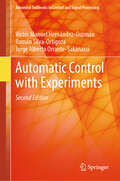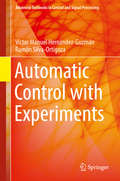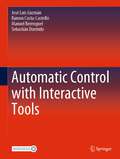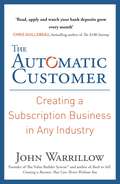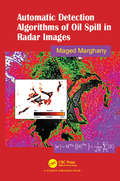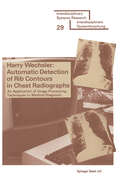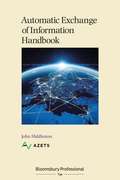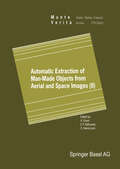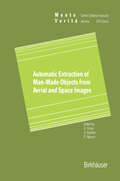- Table View
- List View
Automatic Control of Food Manufacturing Processes
by I. McFarlaneIn the ten years since the first edition of this book appeared there have been significant developments in food process engineering, notably in biotechnology and membrane application. Advances have been made in the use of sensors for process control, and the growth of information technology and on-line computer applications continues apace. In addition, plant investment decisions are increasingly determined by quality assurance considerations and have to incorporate a greater emphasis on health and safety issues. The content of this edition has been rearranged to include descriptions of recent developments and to reflect the influence of new technology on the control and operations of automated plant. Original examples have been retained where relevant and these, together with many new illustrations, provide a comprehensive guide to good practice.
Automatic Control, Robotics, and Information Processing (Studies in Systems, Decision and Control #296)
by Piotr Kulczycki Józef Korbicz Janusz KacprzykThis book presents a wide and comprehensive range of issues and problems in various fields of science and engineering, from both theoretical and applied perspectives. The desire to develop more effective and efficient tools and techniques for dealing with complex processes and systems has been a natural inspiration for the emergence of numerous fields of science and technology, in particular control and automation and, more recently, robotics. The contributions gathered here concern the development of methods and algorithms to determine best practices regarding broadly perceived decisions or controls. From an engineering standpoint, many of them focus on how to automate a specific process or complex system. From a tools-based perspective, several contributions address the development of analytic and algorithmic methods and techniques, devices and systems that make it possible to develop and subsequently implement the automation and robotization of crucial areas of human activity. All topics discussed are illustrated with sample applications.
Automatic Control Systems: With MATLAB
by S. PalaniThis book is designed to serve as a textbook for courses offered to undergraduate students enrolled in Electrical Engineering and related disciplines. The book provides a comprehensive coverage of linear system theory. In this book, the concepts around each topic are well discussed with a full-length presentation of numerical examples. Each example is unique in its way, and it is graded sequentially. This book highlights simple methods for solving problems. Even though, the subject requires a very strong mathematical foundation, wherever possible, rigorous mathematics is simplified for a quick understanding of the basic concepts. The book also includes select numerical problems to test the capability of the students. Time and frequency domain approaches for the analysis and design of linear automatic control systems have been explained using state-space and transfer function models of physical systems. All the chapters include a short theoretical summary of the topic followed by exercises on solving complex problems using MATLAB commands. In addition, each chapter offers a large number of end-of-chapter homework problems. This second edition includes a new chapter on state-space modeling and analysis. Detailed conceptual coverage and pedagogical tools make this an ideal textbook for students and researchers enrolled in electrical engineering and related programs.
Automatic Control Systems in Biomedical Engineering: An Interactive Educational Approach
by J. Fernández de Cañete C. Galindo J. Barbancho A. LuqueThis book presents the fundamental principles and challenges encountered in the control of biomedical systems, providing practical solutions and suggesting alternatives. The perspective of the text is based on the system behaviour in the time domain both linear and non-linear, continuous and discrete, helping the reader to be able to interpret the physical significance of mathematical results during control system analysis and design focusing on biomedical engineering applications. Interactive learning is promoted, endowing students with the ability to change parameters and conditions during the simulation and see the effects of these changes, by using interactive MATLAB and SIMULINK software tools, also presenting realistic problems in order to analyse, design and develop automatic control systems. The text is also complemented with MATLAB and SIMULINK exercise files solved to aid students to focus on the fundamental concepts treated throughout the book, following a new pedagogical approach distinct from the classical one whereby fundamental control concepts are introduced together with adequate software tools in order to gain insight on the biomedical engineering control problems. The book is suitable for second or third-year undergraduate students who will find the illustrative examples particularly useful to their studies of control system design and implementation. Lecturers in the control field will find the computer aided design approach as an alternative to teaching the fundamental concepts of feedback analogic and digital control.
Automatic Control with Experiments (Advanced Textbooks in Control and Signal Processing)
by Victor Manuel Hernández-Guzmán Ramón Silva-Ortigoza Jorge Alberto Orrante-SakanassiThis book offers an enhanced and comprehensive understanding of control theory and its practical applications. The theoretical chapters on control tools have been meticulously revised and improved to provide a clearer and more insightful exploration of the fundamental concepts and ideas. The explanations have been refined, and new examples have been added to aid comprehension. Additionally, a new chapter on discrete-time systems has been included, delving into an important aspect of control theory. Advanced topics in control are also covered in greater detail, ensuring a comprehensive treatment of the subject matter. The section on experimental applications has been revamped to showcase the application of control ideas in various scenarios. Several chapters have been replaced with fresh content that focuses on controlling new and different experimental prototypes. These examples illustrate how control concepts can be effectively applied in real-world situations. Furthermore,this book introduces a new approach for control of non-minimum phase systems and explores the concept of differential flatness for multiple-input multiple-output systems. Additionally, a fascinating application involving a wheeled pendulum mobile robot has been included. While some chapters have been replaced, the second edition retains the chapters on the control of DC motors and the control of a magnetic levitation system. However, the material in the former chapter is mostly new, and the latter chapter is entirely supported by new control concepts and ideas.
Automatic Control with Experiments (Advanced Textbooks in Control and Signal Processing)
by Victor Manuel Hernández-Guzmán Ramón Silva-OrtigozaThis textbook presents theory and practice in the context of automatic control education. It presents the relevant theory in the first eight chapters,applying them later on to the control of several real plants. Each plant is studied following a uniform procedure: a) the plant’s functionis described, b) a mathematical model is obtained, c) plant construction is explained in such a way that the reader can build his or her own plant to conduct experiments, d) experiments are conducted to determine the plant’s parameters, e) a controller is designed using the theory discussed in the first eight chapters, f) practical controller implementation is performed in such a way that the reader can build the controller in practice, and g) the experimental results are presented. Moreover, the book provides a wealth of exercises and appendices reviewing the foundations of several concepts and techniques in automatic control. The control system construction proposed is based on inexpensive, easy-to-use hardware. An explicit procedure for obtaining formulas for the oscillation condition and the oscillation frequency of electronic oscillator circuits is demonstrated as well.
Automatic Control with Interactive Tools
by José Luis Guzmán Ramon Costa-Castelló Manuel Berenguel Sebastián DormidoAutomatic Control with Interactive Tools is a textbook for undergraduate study of automatic control. Providing a clear course structure, and covering concepts taught in engineering degrees, this book is an ideal companion to those studying or teaching automatic control. The authors have used this text successfully to teach their students.By providing unique interactive tools, which have been designed to illustrate the most important automatic control concepts, Automatic Control with Interactive Tools helps students overcome the potential barriers presented by the significant mathematical content of automatic control courses. Even when they have previously had only the benefit of an introductory control course, the software tools presented will help readers to get to grips with the use of such techniques as differential equations, linear algebra, and differential geometry. This textbook covers the breadth of automatic control topics, including time responses of dynamic systems, the Nyquist criterion and PID control. It switches smoothly between analytical and practical approaches. Automatic Control with Interactive Tools offers a clear introduction to automatic control, ideal for undergraduate students, instructors and anyone wishing to familiarize themselves with the fundamentals of the subject
The Automatic Customer: Creating a Subscription Business in Any Industry
by John WarrillowIn The Automatic Customer, John Warrillow provides the essential blueprint for turning your customers into subscribersThe lifeblood of your business is repeat customers. But customers can be fickle, markets shift and competitors are ruthless. So how do you ensure a steady flow of business? The secret - no matter what industry you're in - is finding and keeping automatic customers.These days virtually anything you need can come through a subscription. Far beyond Spotify and Netflix, companies in nearly any industry, from home contractors to florists, can build subscriptions into their business.Subscription is the key to increasing cash flow, igniting growth and boosting the value of your company. Whether you want to transform your entire business into a recurring revenue engine or just pick up an extra 5 per cent of sales growth, The Automatic Customer will be your secret weapon.'Read, apply and watch your bank deposits grow every month' Chris Guillebeau, bestselling author of The $100 Startup'If you have a business, or are thinking about starting one, this book will be the best investment you've ever made' Bo Burlingham, editor-at-large of Inc. and author of Small Giants and Finish BigJohn Warrillow, the author of Built to Sell, is the founder of The Value Builder System™ where advisors help company owners increase the value of their business. Previously, he founded Warrillow & Co., a subscription-based research business dedicated to helping Fortune 500 companies market to small business owners. A sought-after speaker and popular Inc.com columnist, he lives in Toronto.
Automatic Defense Against Zero-day Polymorphic Worms in Communication Networks
by Mohssen Mohammed Al-Sakib Khan PathanAble to propagate quickly and change their payload with each infection, polymorphic worms have been able to evade even the most advanced intrusion detection systems (IDS). And, because zero-day worms require only seconds to launch flooding attacks on your servers, using traditional methods such as manually creating and storing signatures to de
Automatic Defense Against Zero-day Polymorphic Worms in Communication Networks
by Mohssen Mohammed Al-Sakib Khan PathanAble to propagate quickly and change their payload with each infection, polymorphic worms have been able to evade even the most advanced intrusion detection systems (IDS). And, because zero-day worms require only seconds to launch flooding attacks on your servers, using traditional methods such as manually creating and storing signatures to de
Automatic Design of Decision-Tree Induction Algorithms (SpringerBriefs in Computer Science)
by Rodrigo C. Barros André C.P.L.F de Carvalho Alex A. FreitasPresents a detailed study of the major design components that constitute a top-down decision-tree induction algorithm, including aspects such as split criteria, stopping criteria, pruning and the approaches for dealing with missing values. Whereas the strategy still employed nowadays is to use a 'generic' decision-tree induction algorithm regardless of the data, the authors argue on the benefits that a bias-fitting strategy could bring to decision-tree induction, in which the ultimate goal is the automatic generation of a decision-tree induction algorithm tailored to the application domain of interest. For such, they discuss how one can effectively discover the most suitable set of components of decision-tree induction algorithms to deal with a wide variety of applications through the paradigm of evolutionary computation, following the emergence of a novel field called hyper-heuristics."Automatic Design of Decision-Tree Induction Algorithms" would be highly useful for machine learning and evolutionary computation students and researchers alike.
Automatic Detection Algorithms of Oil Spill in Radar Images
by Maged MarghanySynthetic Aperture Radar Automatic Detection Algorithms (SARADA) for Oil Spills conveys the pivotal tool required to fully comprehend the advanced algorithms in radar monitoring and detection of oil spills, particularly quantum computing and algorithms as a keystone to comprehending theories and algorithms behind radar imaging and detection of marine pollution. Bridging the gap between modern quantum mechanics and computing detection algorithms of oil spills, this book contains precise theories and techniques for automatic identification of oil spills from SAR measurements. Based on modern quantum physics, the book also includes the novel theory on radar imaging mechanism of oil spills. With the use of precise quantum simulation of trajectory movements of oil spills using a sequence of radar images, this book demonstrates the use of SARADA for contamination by oil spills as a promising novel technique. Key Features: Introduces basic concepts of a radar remote sensing. Fills a gap in the knowledge base of quantum theory and microwave remote sensing. Discusses the important aspects of oil spill imaging in radar data in relation to the quantum theory. Provides recent developments and progresses of automatic detection algorithms of oil spill from radar data. Presents 2-D oil spill radar data in 4-D images.
Automatic Detection Algorithms of Oil Spill in Radar Images
by Maged MarghanySynthetic Aperture Radar Automatic Detection Algorithms (SARADA) for Oil Spills conveys the pivotal tool required to fully comprehend the advanced algorithms in radar monitoring and detection of oil spills, particularly quantum computing and algorithms as a keystone to comprehending theories and algorithms behind radar imaging and detection of marine pollution. Bridging the gap between modern quantum mechanics and computing detection algorithms of oil spills, this book contains precise theories and techniques for automatic identification of oil spills from SAR measurements. Based on modern quantum physics, the book also includes the novel theory on radar imaging mechanism of oil spills. With the use of precise quantum simulation of trajectory movements of oil spills using a sequence of radar images, this book demonstrates the use of SARADA for contamination by oil spills as a promising novel technique. Key Features: Introduces basic concepts of a radar remote sensing. Fills a gap in the knowledge base of quantum theory and microwave remote sensing. Discusses the important aspects of oil spill imaging in radar data in relation to the quantum theory. Provides recent developments and progresses of automatic detection algorithms of oil spill from radar data. Presents 2-D oil spill radar data in 4-D images.
Automatic Detection of Irony: Opinion Mining in Microblogs and Social Media
by Jihen Karoui Farah Benamara Veronique MoriceauIn recent years, there has been a proliferation of opinion-heavy texts on the Web: opinions of Internet users, comments on social networks, etc. Automating the synthesis of opinions has become crucial to gaining an overview on a given topic. Current automatic systems perform well on classifying the subjective or objective character of a document. However, classifications obtained from polarity analysis remain inconclusive, due to the algorithms' inability to understand the subtleties of human language. Automatic Detection of Irony presents, in three stages, a supervised learning approach to predicting whether a tweet is ironic or not. The book begins by analyzing some everyday examples of irony and presenting a reference corpus. It then develops an automatic irony detection model for French tweets that exploits semantic traits and extralinguistic context. Finally, it presents a study of portability in a multilingual framework (Italian, English, Arabic).
Automatic Detection of Irony: Opinion Mining in Microblogs and Social Media
by Jihen Karoui Farah Benamara Veronique MoriceauIn recent years, there has been a proliferation of opinion-heavy texts on the Web: opinions of Internet users, comments on social networks, etc. Automating the synthesis of opinions has become crucial to gaining an overview on a given topic. Current automatic systems perform well on classifying the subjective or objective character of a document. However, classifications obtained from polarity analysis remain inconclusive, due to the algorithms' inability to understand the subtleties of human language. Automatic Detection of Irony presents, in three stages, a supervised learning approach to predicting whether a tweet is ironic or not. The book begins by analyzing some everyday examples of irony and presenting a reference corpus. It then develops an automatic irony detection model for French tweets that exploits semantic traits and extralinguistic context. Finally, it presents a study of portability in a multilingual framework (Italian, English, Arabic).
Automatic Detection of Rib Contours in Chest Radiographs: An Application of Image Processing Techniques in Medical Diagnosis (Interdisciplinary Systems Research)
by WECHSLER1.1 Statement of the Problem This work describes a new and effective computer algorithm for detecting the contours of ribs in ehest radiographs. The problem, which is common to both the research areas of Machine Vision and Biomedical Computing, is to extract graphical information, such as that represented in Figure 1-lb, from a picture such as Figure 1-la. Figure 1-la shows a typical posterior-anterior (PA) ehest radiograph while Figure 1-lb shows a drawing of the ventral aspect of the thorax. lt is hoped that this researchwill contribute significantly toward developing an automated system for interpreting ehest radio graphs. 1.2 Why Have We Carried Out This Research? Since about one-third of the 650,000,000 medical radiographs (X-ray photographs) taken annually in the United States areehest radiographs, there is a growing awareness of the need for a computer aided system to help diagnose these radiographs. The detection of rib contours is, of course, a necessary element in such a system. In addition to being able to accommodate the need for a mass screening program, an automated systemalso has the ability to detect anomalies at earlier stages. Ziskin et al (1971) state that reliable 2 {a) Original Chest Radiograph Figure 1-1. A Chest Radiograph 3 VENTRAL CONTOUR CARTILAGE {b) THE THORAX; VENTRAL ASPECT OF A CHEST RADIOGRAPH Figura 1-1 A CHEST RADIOGRAPH studies indicate that even under routine conditions radiologists fail to detect approximately 30% of abnormalities in ehest X-ray films.
Automatic Detection of Verbal Deception (Synthesis Lectures on Human Language Technologies)
by Eileen Fitzpatrick Joan Bachenko Tommaso FornaciariThe attempt to spot deception through its correlates in human behavior has a long history. Until recently, these efforts have concentrated on identifying individual "cues" that might occur with deception. However, with the advent of computational means to analyze language and other human behavior, we now have the ability to determine whether there are consistent clusters of differences in behavior that might be associated with a false statement as opposed to a true one. While its focus is on verbal behavior, this book describes a range of behaviors—physiological, gestural as well as verbal—that have been proposed as indicators of deception. An overview of the primary psychological and cognitive theories that have been offered as explanations of deceptive behaviors gives context for the description of specific behaviors. The book also addresses the differences between data collected in a laboratory and "real-world" data with respect to the emotional and cognitive state of the liar. It discusses sources of real-world data and problematic issues in its collection and identifies the primary areas in which applied studies based on real-world data are critical, including police, security, border crossing, customs, and asylum interviews; congressional hearings; financial reporting; legal depositions; human resource evaluation; predatory communications that include Internet scams, identity theft, and fraud; and false product reviews. Having established the background, this book concentrates on computational analyses of deceptive verbal behavior that have enabled the field of deception studies to move from individual cues to overall differences in behavior. The computational work is organized around the features used for classification from ����-gram through syntax to predicate-argument and rhetorical structure. The book concludes with a set of open questions that the computational work has generated.
Automatic Differentiation: (pdf) (Lecture Notes in Computational Science and Engineering #50)
by H. Martin Bücker George Corliss Paul Hovland Uwe Naumann Boyana NorrisAutomatic Differentiation of Algorithms: From Simulation to Optimization
by George Corliss Christele Faure Andreas Griewank Laurent Hascoet Uwe NaumannA survey book focusing on the key relationships and synergies between automatic differentiation (AD) tools and other software tools, such as compilers and parallelizers, as well as their applications. The key objective is to survey the field and present the recent developments. In doing so the topics covered shed light on a variety of perspectives. They reflect the mathematical aspects, such as the differentiation of iterative processes, and the analysis of nonsmooth code. They cover the scientific programming aspects, such as the use of adjoints in optimization and the propagation of rounding errors. They also cover "implementation" problems.
Automatic Digital Document Processing and Management: Problems, Algorithms and Techniques (Advances in Computer Vision and Pattern Recognition)
by Stefano FerilliThis text reviews the issues involved in handling and processing digital documents. Examining the full range of a document’s lifetime, the book covers acquisition, representation, security, pre-processing, layout analysis, understanding, analysis of single components, information extraction, filing, indexing and retrieval. Features: provides a list of acronyms and a glossary of technical terms; contains appendices covering key concepts in machine learning, and providing a case study on building an intelligent system for digital document and library management; discusses issues of security, and legal aspects of digital documents; examines core issues of document image analysis, and image processing techniques of particular relevance to digitized documents; reviews the resources available for natural language processing, in addition to techniques of linguistic analysis for content handling; investigates methods for extracting and retrieving data/information from a document.
Automatic Disambiguation of Author Names in Bibliographic Repositories (Synthesis Lectures on Information Concepts, Retrieval, and Services)
by Anderson A. Ferreira Marcos André Gonçalves Alberto H. LaenderThis book deals with a hard problem that is inherent to human language: ambiguity. In particular, we focus on author name ambiguity, a type of ambiguity that exists in digital bibliographic repositories, which occurs when an author publishes works under distinct names or distinct authors publish works under similar names. This problem may be caused by a number of reasons, including the lack of standards and common practices, and the decentralized generation of bibliographic content. As a consequence, the quality of the main services of digital bibliographic repositories such as search, browsing, and recommendation may be severely affected by author name ambiguity. The focal point of the book is on automatic methods, since manual solutions do not scale to the size of the current repositories or the speed in which they are updated. Accordingly, we provide an ample view on the problem of automatic disambiguation of author names, summarizing the results of more than a decade of research on this topic conducted by our group, which were reported in more than a dozen publications that received over 900 citations so far, according to Google Scholar. We start by discussing its motivational issues (Chapter 1). Next, we formally define the author name disambiguation task (Chapter 2) and use this formalization to provide a brief, taxonomically organized, overview of the literature on the topic (Chapter 3). We then organize, summarize and integrate the efforts of our own group on developing solutions for the problem that have historically produced state-of-the-art (by the time of their proposals) results in terms of the quality of the disambiguation results. Thus, Chapter 4 covers HHC - Heuristic-based Clustering, an author name disambiguation method that is based on two specific real-world assumptions regarding scientific authorship. Then, Chapter 5 describes SAND - Self-training Author Name Disambiguator and Chapter 6 presents two incremental author name disambiguation methods, namely INDi - Incremental Unsupervised Name Disambiguation and INC- Incremental Nearest Cluster. Finally, Chapter 7 provides an overview of recent author name disambiguation methods that address new specific approaches such as graph-based representations, alternative predefined similarity functions, visualization facilities and approaches based on artificial neural networks. The chapters are followed by three appendices that cover, respectively: (i) a pattern matching function for comparing proper names and used by some of the methods addressed in this book; (ii) a tool for generating synthetic collections of citation records for distinct experimental tasks; and (iii) a number of datasets commonly used to evaluate author name disambiguation methods. In summary, the book organizes a large body of knowledge and work in the area of author name disambiguation in the last decade, hoping to consolidate a solid basis for future developments in the field.
Automatic Exchange of Information Handbook
by John HiddlestonAutomatic Exchange of Information Handbook is a practical guide to the automatic exchange of information rules legislation within the UK. Covering the requirements of the OECD Common Reporting Standard (CRS), and the US Foreign Account Tax Compliance Act (FATCA) on financial institutions, this title helps to explain: - What the key jargon means- How to work out the status of an organisation under these rules (the definition of financial institutions may include professional firms, charities and trusts)- The potential penalties and other risks of non-compliance and how to minimise those risks- How to achieve compliance, including: - How to carry out the required due diligence- How to make a reportThe title summarises a brief history of AEOI, the impact of Brexit, who is affected and how, due diligence requirements, and more, as well as other issues including other forms of international information exchange such as anti-money laundering rules and bi-lateral double taxation treaties. Key points are clearly highlighted throughout for easy references and flowcharts are included to support some areas of commentary. This title is essential for tax advisers, accountants, tax lawyers, financial advisers and students studying for international tax qualifications. It will also be relevant for finance and management teams in organisations which fall under these rules in practice.
Automatic Extraction of Man-Made Objects from Aerial and Space Images (Monte Verita)
by Armin Gruen E. P. Baltsavias O. HenricssonAdvancements in digital sensor technology, digital image analysis techniques, as well as computer software and hardware have brought together the fields of computer vision and photogrammetry, which are now converging towards sharing, to a great extent, objectives and algorithms. The potential for mutual benefits by the close collaboration and interaction of these two disciplines is great, as photogrammetric know-how can be aided by the most recent image analysis developments in computer vision, while modern quantitative photogrammetric approaches can support computer vision activities. Devising methodologies for automating the extraction of man-made objects (e.g. buildings, roads) from digital aerial or satellite imagery is an application where this cooperation and mutual support is already reaping benefits. The valuable spatial information collected using these interdisciplinary techniques is of improved qualitative and quantitative accuracy. This book offers a comprehensive selection of high-quality and in-depth contributions from world-wide leading research institutions, treating theoretical as well as implementational issues, and representing the state-of-the-art on this subject among the photogrammetric and computer vision communities.
Automatic Extraction of Man-Made Objects from Aerial Space Images (Monte Verita)
by Armin Gruen Olaf Kuebler Peggy AgourisAdvancements in digital sensor technology, digital image analysis techniques, as well as computer software and hardware have brought together the fields of computer vision and photogrammetry, which are now converging towards sharing, to a great extent, objectives and algorithms. The potential for mutual benefits by the close collaboration and interaction of these two disciplines is great, as photogrammetric know-how can be aided by the most recent image analysis developments in computer vision, while modern quantitative photogrammetric approaches can support computer vision activities. Devising methodologies for automating the extraction of man-made objects (e.g. buildings, roads) from digital aerial or satellite imagery is an application where this cooperation and mutual support is already reaping benefits. The valuable spatial information collected using these interdisciplinary techniques is of improved qualitative and quantitative accuracy. This book offers a comprehensive selection of high-quality and in-depth contributions from world-wide leading research institutions, treating theoretical as well as implementational issues, and representing the state-of-the-art on this subject among the photogrammetric and computer vision communities.
Automatic Fingerprint Recognition Systems
by Nalini Ratha Ruud BolleAn authoritative survey of intelligent fingerprint-recognition concepts, technology, and systems is given. Editors and contributors are the leading researchers and applied R&D developers of this personal identification (biometric security) topic and technology. Biometrics and pattern recognition researchers and professionals will find the book an indispensable resource for current knowledge and technology in the field.




